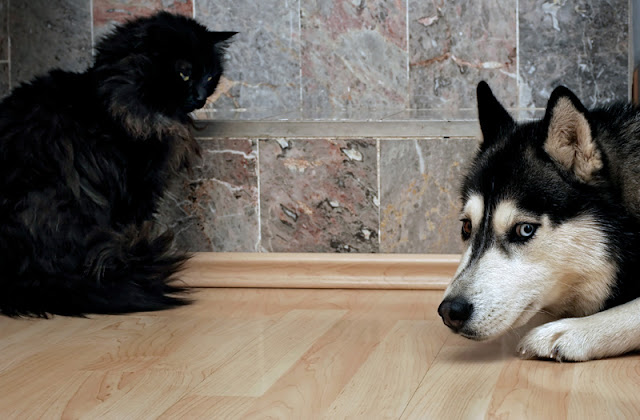 |
| Photo: Samarsky / Shutterstock |
Cat owners know only too well that cats can be choosy. As solitary hunters, the domestic cat can do just fine alone and does not have to be friends with other members of the species. On the other hand, cats can live in social groups, especially in colonies of female cats and their offspring, when female cats will help care for each other’s young.
Many people have multiple pet cats and they aren’t always friends. It is obvious cats don’t get along if they fight. But there are also more subtle signs of cat aggression, such as when one cat blocks another cat’s access to a resource like the litter box. As well as bouts of aggression, when cats don’t get along they may hold urine for too long, pee outside the box, suffer feline idiopathic cystitis, over-eat or lose weight, or sometimes (if they have outdoors access) one of them may even leave home.
Resolving aggression between cats may involve reintroducing cats, changes to the layout of the home (such as multiple, separated resources), behavioral work such as counter-conditioning, and/or medication.
A study by veterinary behaviourist Dr. Theresa DePorter and colleagues, published in the Journal of Feline Medicine and Surgery, investigates the effectiveness of a synthetic cat-appeasing pheromone in resolving cases of aggression in multi-cat households.
As the scientists write in the introduction to the paper,
“The wellbeing of millions of cats may be enhanced if cats got along with housemate cats.”Although this is a pilot study, it is a double-blind randomized controlled trial with a placebo.
Pheromones are semiochemicals, that is, chemicals with meaning. Pheromones are very important to cats and some help maintain social cohesion.
The synthetic cat-appeasing pheromone used in the study is FELIWAY MultiCat
The synthetic pheromone is in a diffuser that is plugged into a socket. Therefore the placebo was also a plug-in and looked the same.
 |
| Photo: joyfuldesigns / Shutterstock |
Forty-five people with 2-5 cats in the home and who reported aggression between cats were enrolled in the study. Three households did not complete the study and so the final sample was 17 households that received Feliway Multicat and 25 that received the placebo.
One week before the start of the treatment, participants attended a 90-minute training session with a board-certified veterinary behaviourist. The session included information and video to teach them how to recognize feline aggression and how to tell the difference between play and aggression. As well, participants were given information on counter-conditioning, advice on what to do if their cats were being aggressive, and told not to use punishment (e.g. spray bottles) or startle their cats. (For more on why you shouldn’t use spray bottles for cats, see this nice post from Julie Hecht).
Participants drew a plan of their house and the scientists decided the best place to plug in the two diffusers (either Feliway Multicat or placebo). The diffusers were used for 28 days during which cat owners filled out a daily diary and a weekly questionnaire about their cats’ behaviour.
Even before the start of the treatment, rates of reported aggression dropped, likely due to the education session. Twelve types of aggressive behaviour between cats were included in the questionnaire.
During the 28-day period of using the plug-ins, aggression decreased in both groups, but it decreased significantly more in the group using Feliway Multicat. During a two-week follow-up, aggressive behaviours remained low in the group that had used Feliway Multicat, but began to go up in the placebo group.
There was no difference between the two groups in terms of affiliate behaviours such as nose-touching, sleeping in the same room, or licking the head or neck of another cat. This category also included affiliative behaviours towards humans, such as whether all cats came to greet the person when they arrived home.
At the end of the study, participants were asked if their cats were getting along better. 84% of the people who had used Feliway Multicat said yes, compared to 64% of those who had the placebo.
47% of the cats in this study were declawed, a much higher proportion than the average in the US (24%). The scientists cite other, unpublished, research that suggests a link between declawing of cats and aggression between cats that live together. Research also shows declawed cats suffer pain and other adverse effects (Martell-Moran et al 2017; you can read more about it in this great post by Dr. Mikel Delgado).
Where I live (BC), declawing of cats is banned, but if you are somewhere this procedure is legal, you should be aware that it has many risks for your cat. The Canadian Veterinary Medical Association calls this surgery “unacceptable.”
But back to the pheromone study. It used owner observations and it is possible people missed some behavioural signs, even though they received training. Participants in the study were given information at the education session, but if owners simply use synthetic pheromones on their own without learning more about cat behaviour they may not see the same results. As well, it would be nice to see a longer follow-up period in future research.
This is the first time Feliway Multicat has been tested in a randomized controlled trial. For more on previous research on other synthetic pheromones for cats, see this list compiled by Dr. Mikel Delgado.
The scientists conclude,
“In this study, treatment with a proprietary cat-appeasing pheromone diffuser for 4 weeks showed a beneficial effect in the management of feline aggression in multi-cat households. During the study, when cat owners were educated by a board-certified veterinary behaviourist about feline behavior, provided instruction on handling aggressive events and discouraged from punishing cats (eg, squirt guns or other startle methods), the level of conflict began to decrease even prior to implementation of the treatment. Pheromones may be useful as a component of a complete behavior-modification program.”While more research is needed, these are promising results that suggest Feliway Multicat may help as part of the treatment for aggression between cats living in the same home. The study is open access (link below).
If you have more than one cat, how well do your cats get on with each other?
If you love Companion Animal Psychology, you can support me on Ko-fi.
References
DePorter, T. L., Bledsoe, D. L., Beck, A., & Ollivier, E. (2018). Evaluation of the efficacy of an appeasing pheromone diffuser product vs placebo for management of feline aggression in multi-cat households: a pilot study. Journal of Feline Medicine and Surgery. https://doi.org/10.1177/1098612X18774437
Martell-Moran, N. K., Solano, M., & Townsend, H. G. (2018). Pain and adverse behavior in declawed cats. Journal of Feline Medicine and Surgery, 20(4), 280-288. https://doi.org/10.1177/1098612X17705044










